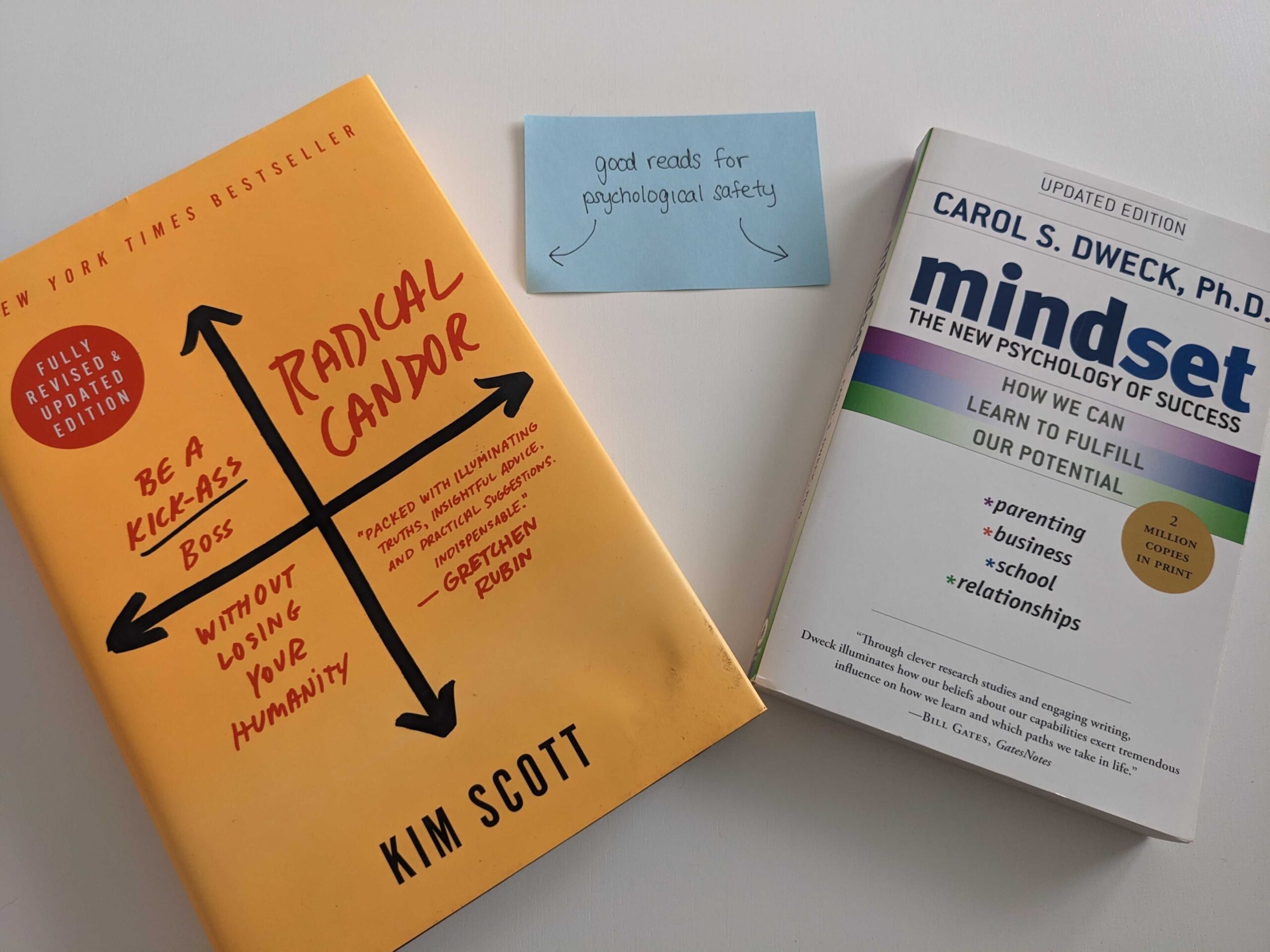The challenges of implementing psychological safety in the workplace
By: Sarah Rosenquist
July 24, 2024 | Reading Time: 10 mins
Discussion about psychological safety in the workplace is everywhere right now. But less than a decade ago, it wasn’t common knowledge. With the recent global pandemic, tumultuous, and divisive political discourse, and all kinds of loss, we’ve all collectively struggled to navigate these unprecedented times and get our jobs done. While the struggle isn’t new, the widespread awareness and empathy around how these challenges impact our ability to do our best work is. Psychological safety has never been more important.
For us, 2016 was the year we caught wind of Amy Edmondson’s work with Google on psychological safety. Since then, Stryve has been committed to fostering psychological safety in the workplace. And we’ve learned a ton over the years. It’s an appealing concept but notoriously hard to build, foster, and maintain. Psych safety is a part of every single little interaction you have in a day. So we’re going to break down 3 core challenges and candidly share all that we’ve learned over the years, with the hope that it’ll make it a little bit less difficult to foster.
Candid challenges of implementing psychological safety
1. It’s hard to take psychological safety beyond a buzzword
At the core of psychological safety is a lot of courage and vulnerability. For many people, these are not things that come naturally, especially in the workplace. It requires trust, which is even more difficult to foster in a hierarchical context like a large organization. Psychological safety and being courageous and vulnerable at work is a chicken-and-egg situation.
We started with baby steps—at first, our only goal was to measure our psychological safety bi-annually. We patted ourselves on the back when we got it done. Everyone needs to start somewhere, so if you’re struggling to put psychological safety into action, perhaps these tips and stories will help.

Remember: Psychological safety does not mean dodging accountability
When starting to build psychological safety in the workplace, it can be hard to get into the habit of checking yourself and others. It’s new territory and it’s particularly risky to be the leader who needs to model the behaviour for everyone else. But if you’re reading this, you want or need to make it happen. And that means holding yourself and others accountable for it.
Early in my career, there was a time when I was late for a very important carpool to the airport so we could fly out to see a client. The team had to wait for me and even reschedule our flights. How did I repay them for their patience and accommodation? I was angry and snippy with them in the car as I ranted about how alarms were clearly not loud enough if three of them couldn’t wake me. No wonder they didn’t feel like they could talk to me about how big of a deal my tardiness was. I did a terrible job of owning up to what I did and making them feel safe to bring it up. What I needed to do was accept that I goofed, be kind to myself, and thus be in a spot where I could take ownership and be kind to others.
Reflect: Look at your insecurities with compassion to start taking accountability
If you’re finding it difficult to be open about your own mistakes or finding that a team member is often defensive in the face of constructive feedback, use these questions to guide some reflection, journaling, or discussion:
- What are you physically experiencing in the moment? Does your heart rate go up? Does your breathing change? Is it difficult to make eye contact? Do you shrink away from others?
- Are you feeling like you’re out of your depth? Is imposter syndrome part of that? What are you trying to prove to yourself? To others? Do you achieve that 90% of the time and this mistake is an outlier?
- Is perfectionism at play? Do you hold yourself to a higher standard than others? What would you say to someone if the roles were reversed? Is it reasonable to expect yourself to account for every variable all the time?
- What part of you are you protecting? Is it your reputation? Is it your trustworthiness? Your perceived intelligence, diligence, responsiveness? Whatever it is, can you look at it and accept that this part of you is allowed to make mistakes and still be adequate?
All of these prompts circle around the awful feeling that is shame. Everyone’s experiences with shame are incredibly individual, so if the questions here aren’t hitting there are plenty of resources available to continue this work, such as Brené Brown’s content, and hopefully your organization’s health benefits cover sessions with a registered therapist.
Apply: Trust in yourself and your team
Someone has to be the first to dive in. Someone has to forge the path forward to show what a psychologically safe workplace looks like. But being courageous and vulnerable is uncomfortable. Sometimes it’s downright painful. Creating meaningful change and inspiring leadership requires that you can persevere through it.
- Do the inner work. To be courageous and vulnerable, you have to be able to look at your own fears and limits with love. They’re an opportunity to overcome, learn, and grow. You need to be able to recognize what privilege and biases you have and resolve to check yourself on an ongoing basis.
- Find your psych safety buddy. This will be someone you already have good rapport and trust with, ideally without any workplace power dynamics at play. Promise to hold each other accountable. Give them the green light to give you a reality check (and don’t react poorly when they do).
- Align with other leaders. A united leadership team means that you’re in it together to learn about psychological safety. You’ll improve and grow together. You’ll take the risk of being vulnerable and accountable first, but with the safety of your position of power. It won’t go unnoticed and will make it easier for those without a privileged position in the organization.

2. It’s easy to take psychological safety too far into ruinous empathy
Ruinous empathy is a dramatic term coined in Kim Scott’s Radical Candor. She describes it as when you care deeply about a person, but don’t pair that with direct (and often challenging) communication. In the world of psychological safety, this looks like being too considerate of others’ feeling of safety to the point of not taking a risk yourself in sharing tough feedback.
I’ve also been here. You wonder if something is “worth” bringing up. You don’t want to rock the boat or ruin someone’s day. That fear is valid, but it’s not serving that person’s long-term best interests, which are learning and growing and building new skills.
Remember: Psychological safety is not a no-criticism zone
It’s not fun knowing that you’ve goofed something up. It’s also not fun pointing out when someone else was missing the mark. When creating psychological safety in the workplace, it’s easy to get caught up in the part of the definition that talks about “no negative consequences”, and think that constructive feedback is a negative consequence.
Last year I was struggling with some incredibly difficult personal circumstances. The love, care, and support I received from the team was equally incredible. But I got stuck in a mindset where I selfishly didn’t want to add any more difficulty to my life by sharing constructive feedback. I didn’t want to have uncomfortable conversations at work. It was easier for me to let things slide. It was also probably easier for the team to let my mistakes slide. We avoided conversations with the admirable, but ultimately detrimental, intent to not add anything hard to my plate. While I can’t go back and recapture those lost moments of learning and development for myself and the team, I can do better next time. This is a prime example of pointing out ruinous empathy.
Reflect: Shine a light on why constructive feedback is hard to learn where you need work
If you find yourself holding back constructive feedback or find a team member is often venting about a situation instead of addressing it outright, use these questions to guide some reflection, journaling, or discussion:
- Are you unsure how to deliver the feedback? Are you worried that it will make you appear cruel and uncaring? Will you come off as nit-picky and micromanaging? Is it just a matter of having the right tips and tricks for sharing constructive feedback, or are there other factors holding you back?
- Do you feel like it isn’t worth it to address the issue? Is it something you (and the team) are alright with continuing? What emotions are coming up when it happens? (All of them are valid by the way). Are there other ways beside avoidance that could address those feelings?
- Are you not in the right headspace? Does this need to be addressed immediately, or can you take time to get in the right headspace? Are there power dynamics or interpersonal issues behind what you’re experiencing? Are you uncomfortable sharing what you’re experiencing?
- Are you simply too busy? Is there a pocket of time in the future you can use to provide the feedback? Is this issue contributing to why you’re too busy? Why might it take a long time to correct the behaviour?
Apply: Get in a growth mindset and share that feedback
One thing that’s consistently helped us in all of these scenarios is that you and your team can apply a growth mindset to any of these struggles. A growth mindset, as coined by Carol Dweck, is a belief that skills and talents can be developed through effort, strategy, feedback, and collaboration. It opposes a fixed mindset; the belief that your or others’ talents are innate and can’t meaningfully change. Everyone experiences and fluctuates between both, so the key to maintaining psychological safety in the workplace while still delivering constructive feedback is to do it when you believe in growth.
There are great tips on shifting into a growth mindset and here are the ones I have found most personally impactful:
- Embrace your imperfection. Can you allow yourself to make mistakes with a promise to learn from them? This applies to the feedback you share! With practice, you’ll get better at how you approach and phrase your feedback. It’s incredibly difficult to help someone improve without giving yourself that grace first.
- Look to the future. Are you telling yourself you can’t give that feedback? That someone can’t do what you need them to? Those could very well be true right now, but what about tomorrow or next month? Try simply adding the word “yet” to the end of those thoughts to break from the fixed mindset.
- Acknowledge and address the discomfort. It’s ok to be feeling a certain way about giving and receiving feedback. We’re programmed to avoid those uncomfortable feelings. The more you can care for yourself and others experiencing those feelings, the better you can navigate change together.
- Talk about effort and results. They don’t always go hand-in-hand, but you’ll never get the results you’re looking for without effort on both sides. That’s your effort in supporting their growth as much as it is their effort in addressing the feedback. Make sure you’re discussing the end goal and the steps made towards that on both sides of the equation.

3. Psychological safety at work is a messy balancing act
Like the economy and weather in Canada, fostering psychological safety with your team is a pendulum that swings to both sides and merely passes through that ideal middle zone. It’s not static. Some days you’ll be able to dedicate your time and energy to sharing yourself and creating space for others to do the same. Other days you’ll be nose to the grindstone and focused elsewhere. It’s normal. Yes, creating a psychologically safe workplace is about many tiny moments, but the big picture over a long time horizon is what matters most.
Remember: Psychological safety is not about continuous perfection
It’s about continuous improvement. It’s about making progress towards your team showing up more authentically at work so that they can take risks, learn, and grow. We all have days that aren’t our best, and we also have days when when we are totally rocking it. Success with psychological safety looks like an upward trend line when smoothed for the day-to-day variation.
Reflect: Explore the nuance behind conflict and differences
Disagreements and opposing opinions will inevitably pop up. If they don’t, your team likely isn’t feeling psychologically safe enough to take risks or voice their opinions. When facing a situation that isn’t sailing smoothly, consider these underlying factors:
- What assumptions are you making? Does a teammate have past experiences that are different from yours and that’s leading to different viewpoints? Could there be something going on outside of work that is at play? Are we interpreting the direction for this task differently?
- What is “good enough”? Has your definition changed over time? Why does that differ from others’ definitions? What external pressures (time, budgets, workload) might be affecting the task?
- What can I learn from this experience? Has it uncovered something about myself or others? Can we do the task in a new way that plays to everyone’s strengths?
These prompts aren’t meant to diminish or downplay all conflict. The goal isn’t to be unilaterally positive about everything. What we’re aiming for is to be able to hold space for the different paths we take and baggage we all carry. Hopefully we can look at a disagreement or a plan that didn’t work out with respect for the various and nuanced impacts it can have.
Apply: Keep learning & talking about psychological safety in the workplace
As projects and people come and go, you’ll need to adjust your footing and set the intentions to foster a psychologically safe workplace again and again and again. With consistent effort and visibility, you can increase psychological safety with your team.
- Be a student every day. Keep expanding your understanding of yourself, your team, and the concept of psychological safety. Set up a Google Alert or follow prominent thinkers in the space on socials so that it stays top-of-mind.
- Infuse psychological safety in your processes. Look at how you can incorporate it into your hiring practices, feedback systems, and performance plans/evaluations. Expand the concept to your customers, partners, or vendors if it’s appropriate. Consider how it can be used to set expectations when kicking off a project and evaluating it afterwards.
Reflect on your challenges and keep showing up
Fostering a psychologically safe workplace involves overcoming significant challenges from moving beyond buzzwords, avoiding ruinous empathy, and remaining consistent. What makes it so intricate is that every person is going to face their own personal challenges in helping sustain psych safety efforts. By embracing personal opportunities for improvement and working together, we can champion a more creative and innovative future.








